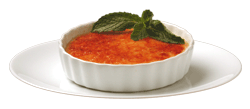
Originally from Catalonia, this dessert is sumptuous but not overbearing if serving sizes are kept to a minimum. Many restaurants in France serve it in small, low-sided, oval-shaped (about 10 ounce, but not full) dishes, but in a pinch it can be served in 5-ounce ramekins instead. Some of the steps are a bit intimidating, but the experience to be gained and the satisfaction from succeeding is well worth it. The tips given are from hard-gained experience. This recipe serves 6.
Ingredients
| 1 | vanilla bean (or 2 tsp of real, liquid extract) |
| 100 gr | granulated sugar (about ½ cup) |
| 1 litre | heavy cream (4 cups) |
| 6 | egg yolks |
| 2 tsp | almond liqueur or 1 teaspoon almond extract |
Preparation
1. Preheat the oven to about 300° in preparation for step 4. Place the ramekins or other serving dishes in an oven dish or deep cookie sheet (i.e.: with sides) and set aside.
2. Scrap the grains from the vanilla bean halved or the liquid vanilla into a mid-sized pan. Add the cream and bring to a boil over medium heat stirring constantly. Remove from the heat, cover and let rest 20 to 30 minutes.
3. In a bowl, beat the egg yolks carefully (don't add any more air than necessary) and the sugar into a creamy mixture. Add the liqueur or almond extract. Beat into this the warmed cream. Pour the cream through a wire strainer into the prepared dishes in the oven dish or cookie sheet. Fill with hot water, cover the whole thing with one sheet of aluminum foil and carefully (!) load into oven.
Tip: I use a commercial half-sheet (for sheet cakes) which I load into the hot oven (creams already in it, sheet already covered). Then I lift up one corner of the foil and quickly (but accurately) pour hot water almost up to the rim using a pitcher.
Tip: The hot water goes into the holding pan. The purpose of this water is to smooth out the cooking process of the custard. (This is a pretty common technique in cooking any custard—flan, crême-brûlée, etc.) It keeps the creams from getting too hot and also distributes the heat evenly around them.
4. Bake in the oven until the cream seizes (gels)—about 30 to 35 minutes. Withdraw the dishes from the oven and set aside for a good hour. Place in refrigerator overnight.
Tip: One thing you'll want to watch is not cooking thing "solid." If they don't jiggle a bit when you take them out, they'll probably be over-done and less enjoyable. This is true also, if less so, of flan. Over-cooked egg is a bad thing. Understanding how not to over-cook it is a challenge.
5. To serve, preheat the broiler to its hottest. (American ovens are usually disappointing here, but try it and see if you can't settle for the result.) Sprinkle sugar over the dishes and place under the heat as close as possible until the sugar layer caramelizes. A balance must be struck between keeping the cream from boiling much and getting the sugar caramelized. Trial and error is the teacher. Return the desserts to the refrigerator until needed.
Tips: Use the oven dish from the eve filled with ice-cold water to preserve the cream during the caramelization process. If your oven is hot enough and the cream doesn't boil, it can be served immediately, the hot caramel contrasting delightfully with the cold cream. Instead of an oven, I have begun using a hand-held butane torch just as I do for my baked Alaska. It achieves both the desired effect on taste and texture and the visual presentation. For this purpose, I purchased a torch in a little box and I reserve it exclusively for kitchen use.